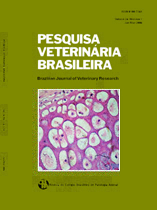 |
|
|
|
Year 2014 - Volume 34, Number 6
|

|
Isoflurane minimum alveolar concentration in collared peccary (Tayassu tajacu), 34(6):576-581
|
ABSTRACT.- Oliveira M.G.C., Morais A.M.L., Lima A.G.A., Paiva A.L.C., Nunes T.L., Passos Y.D.B., Oliveira M.F. & Paula V.V. 2014. [Isoflurane minimum alveolar concentration in collared peccary (Tayassu tajacu).] Determinação da concentração alveolar mínima do isofluorano em catetos (Tayassu tajacu). Pesquisa Veterinária Brasileira 34(6):576-581. Departamento de Ciências Animais, Universidade Federal Rural do Semi-Árido, BR-110 Km 47, Presidente Costa e Silva, Mossoró, RN 59625-900, Brazil. E-mail: glauciacarlos@hotmail.com
Inhalation anesthesia has been widespread in veterinary medicine. Nevertheless, its use in wild animals is still limited, having no studies on its use been observed in the species. The objective of the research was to determine the isoflurane minimum alveolar concentration (MAC) in peccaries and present the effects of its administration on the hemodynamic and respiratory variables, as well as data concerning the anesthesia recovery. The study used 10 male animals with age ranging from one to three years, from the Centro de Multiplicação de Animais Silvestres of Universidade Federal Rural do Semi-Árido, Brazil. All the animals had anesthesia induced with propofol 7mg.kg-1, were intubated and connected to the anesthetic circuit with isoflurane and 100% oxygen. The supramaximal noxious stimulation used was the interdigital pinch, which was performed after 15 minutes of waiting for each provided isoflurane concentration. When negative response to the stimulus was observed, the concentration was reduced by 20%; when positive response was verified, the stimulus was stopped, being the CAM value calculated from that point. Quantitative and qualitative data regarding recovery were also observed. Shapiro-Wilk test for normality was performed, as well as Levene test for equality of variance; the variables were subjected to One Way RM ANOVA for repeated measures followed by Tukey test, and the data expressed as mean and standard deviation. The MAC of isoflurane was 2.4% and the surgical MAC equal to 3.5%. Depressive action of isoflurane on blood pressure, heart and breathing rates was observed when compared to the average of the variables on awake animals; however, during maintenance of anesthesia, they remained stable. Metabolic acidosis was observed in the pre-anesthetic, which was offset after inhalation anesthesia. Recovery was quiet and smooth. It was concluded that the isoflurane MAC for peccaries was greater than that observed in related species. Isoflurane can be used in this species, being considered safe and effective. The animals’ recovery after anesthesia with isoflurane was free from excitement. |
| |
|
|
| |
|
 |